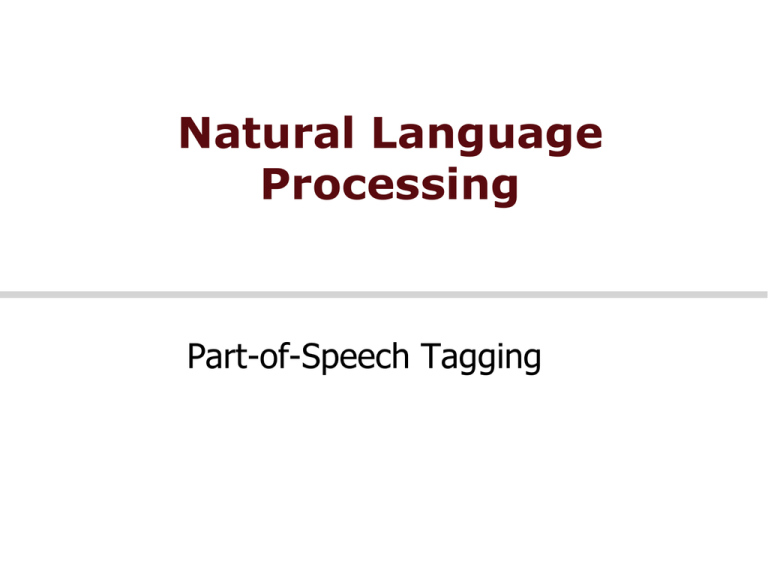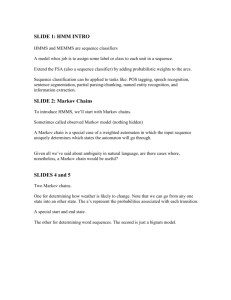Part-of-speech tagging
advertisement

Natural Language Processing Part-of-Speech Tagging Parts of Speech 8–10 traditional parts of speech Noun, verb, adjective, adverb, preposition, article, interjection, pronoun, conjunction, … Variously called: Parts of speech, lexical categories, word classes, morphological classes, lexical tags, ... Lots of debate within linguistics about the number, nature, and universality of these We’ll completely ignore this debate 2 POS Examples N V ADJ ADV P DET INT PRO CONJ noun verb adjective adverb preposition determiner interjection pronoun conjunction chair, bandwidth, pacing study, debate, munch purple, tall, ridiculous unfortunately, slowly of, by, to the, a, that, those ouch, hey I, me, mine and, but, for, because 3 POS Tagging The process of assigning a part-of-speech or lexical class marker to each word in a collection WORD tag the koala put the keys on the table DET N V DET N P DET N 4 Why is POS Tagging Useful? First step of a vast number of practical tasks Speech synthesis How to pronounce “lead”? INsult inSULT OBject obJECT OVERflow overFLOW DIScount disCOUNT CONtent conTENT Parsing Need to know if a word is an N or V before you can parse Information extraction Finding names, relations, etc. Machine Translation 5 Open and Closed Classes Closed class: a small fixed membership Prepositions: of, in, by, … Auxiliaries: may, can, will had, been, … Pronouns: I, you, she, mine, his, them, … Usually function words (short common words which play a role in grammar) Open class: new ones can be created all the time English has 4: Nouns, Verbs, Adjectives, Adverbs Many languages have these 4, but not all! 6 POS Tagging Choosing a Tagset There are so many parts of speech, potential distinctions we can draw To do POS tagging, we need to choose a standard set of tags to work with Could pick very coarse tagsets N, V, Adj, Adv, … More commonly used set is finer grained, the “Penn TreeBank tagset”, 45 tags PRP$, WRB, WP$, VBG Even more fine-grained tagsets exist 7 Penn TreeBank POS Tagset 8 POS Tagging Words often have more than one POS: back The back door = JJ On my back = NN Win the voters back = RB Promised to back the bill = VB The POS tagging problem is to determine the tag for a particular instance of a word These examples from Dekang Lin 9 How Hard is POS Tagging? Measuring Ambiguity 10 Evaluation So once you have you POS tagger running how do you evaluate it? Overall error rate with respect to a manually annotated gold-standard test set Error rates on particular tags Tag confusions ... Accuracy typically reaches 96–97% for English newswire text What about Turkish? What about twitter? 11 Error Analysis Look at a confusion matrix See what errors are causing problems Noun (NN) vs ProperNoun (NNP) vs Adj (JJ) Preterite (VBD) vs Participle (VBN) vs Adjective (JJ) 12











